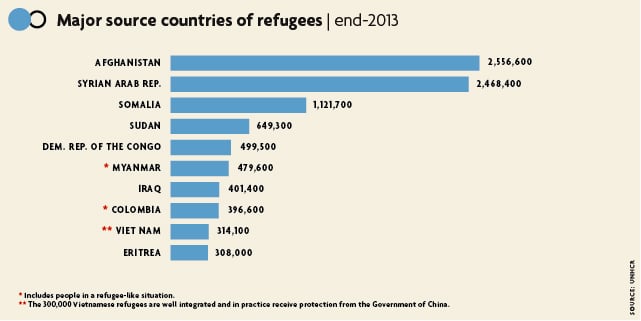Global Trends 2013: UNHCR Releases Annual Refugee Statistics
The
UN refugee agency releases annual statistics showing that more than 51
million people were forcibly displaced at the end of 2013, the largest
number since the end of World War II. Half of the world's refugees in
2013 were children.
World Refugee Day: Global forced displacement tops 50 million for first time in post-World War II era
News Stories, 20 June 2014
GENEVA, June 20 (UNHCR) – The UN refugee
agency reported today on World Refugee Day that the number of refugees,
asylum-seekers and internally displaced people worldwide has, for the
first time in the post-World War II era, exceeded 50 million people.
UNHCR's annual Global Trends report, which is based on data compiled
by governments and non-governmental partner organizations, and from the
organization's own records, shows 51.2 million people were forcibly
displaced at the end of 2013, fully 6 million more than the 45.2 million
reported in 2012.
This massive increase was driven mainly by the war in Syria, which at
the end of last year had forced 2.5 million people into becoming
refugees and made 6.5 million internally displaced. Major new
displacement was also seen in Africa – notably in Central African Republic and South Sudan.
"We are seeing here the immense costs of not ending wars, of failing
to resolve or prevent conflict," said UN High Commissioner for Refugees
António Guterres. "Peace is today dangerously in deficit. Humanitarians
can help as a palliative, but political solutions are vitally needed.
Without this, the alarming levels of conflict and the mass suffering
that is reflected in these figures will continue."
The worldwide total of 51.2 million forcibly displaced represents a
huge number of people in need of help, with implications both for
foreign aid budgets in the world's donor nations and the absorption and
hosting capacities of countries on the front lines of refugee crises.
"The international community has to overcome its differences and find
solutions to the conflicts of today in South Sudan, Syria, Central
African Republic and elsewhere. Non-traditional donors need to step up
alongside traditional donors. As many people are forcibly displaced
today as the entire populations of medium-to-Iarge countries such as
Colombia or Spain, South Africa or South Korea," said Guterres.
Displacement data in the annual report covers refugees,
asylum-seekers and the internally displaced. Among these, refugee
numbers amounted to 16.7 million people worldwide, 11.7 million of whom
are under UNHCR's care and the remainder registered with the UN Relief
and Works Agency for Palestine. These totals alone are the highest UNHCR
has seen since 2001. In addition, more than half of the refugees under
UNHCR's care (6.3 million) had at end 2013 been in exile for more than
five years.
Overall, the biggest refugee populations under UNHCR care and by source country are Afghans, Syrians and Somalis –
together accounting for more than half of the global refugee total.
Pakistan, Iran and Lebanon, meanwhile, hosted more refugees than other
countries.
By region, Asia and the Pacific had the largest refugee population
overall at 3.5 million people. Sub-Saharan Africa had 2.9 million
people, while the Middle East and North Africa had 2.6 million.
In addition to refugees, 2013 saw 1.1 million people submitting
applications for asylum, the majority of these in developed countries
(Germany became the largest single recipient of new asylum claims). A
record 25,300 asylum applications were from children who were separated
from or unaccompanied by parents. Syrians lodged 64,300 claims, more
than any other nationality, followed by asylum seekers from Democratic
Republic of the Congo (60,400) and Myanmar (57,400).
Internal displacement – people forced to flee to other parts of their country –
amounted to a record 33.3 million people, accounting for the largest
increase of any group in the Global Trends report. For UNHCR and other
humanitarian actors, helping these people represents a special challenge
as many are in conflict zones.
Part of UNHCR's work is finding long-term solutions for people who
become forcibly displaced. Where possible this is through voluntary
return, but other possibilities include local integration or
resettlement in third countries. The year 2013 saw the fourth lowest
level of refugee returns in almost a quarter century –
414,600 people. Some 98,400 refugees were resettled in 21 countries.
Full worldwide data on local integration and returns of internally
displaced people (IDP) was not available although 1.4 million of them
returned home in countries where UNHCR is operational with IDPs.
The worldwide population of stateless people is not included in the
figure of 51.2 million forcibly displaced people (since being stateless
doesn't necessarily correlate to being displaced). Statelessness remains
hard to quantify with precision, but for 2013, UNHCR's offices
worldwide reported a figure of almost 3.5 million stateless people. This
is about a third of the number of people estimated to be stateless
globally.
Read the Global Trends 2013 report
25 Years of Displacement
Added: 20 Jun 2014
Global Trends: In 2013, displacement reached the highest level in decades.
25 Years of Displacement (1989-2013)
© UNHCR/Y.LeeImage
Displacement during 25 years (1989-2013)
© UNHCR/Y.LeeImage




No comments:
Post a Comment